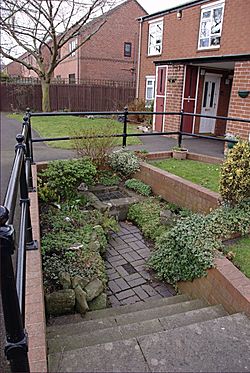Derventio Coritanorum

Derventio or Derventio Coritanorum was a small Roman town on the River Derwent, standing in what is now the northern edge of Derby. Today the area is known as Little Chester.[1]
Description
The first Roman fort in the area was built on the opposite bank of the Derwent at Strutts Park. It was replaced about AD 80 by a fort on the present site, but this only lasted about forty years, then was decommissioned. Archaeology shows extensive Roman activity in the area at these times, prompted by the fort.
The fort was connected westward by a road to the Icknield Street, and to the east by a road to Sawley on the River Trent. A fort-vicus which manufactured pottery and did ironworking was founded 650 yards to the east on the Sawley Road. The fort was later re-occupied and re-used for a further twenty-five years. The defensive bank and timber palisade were now remodelled and stone gates built. Then it lay apparently unoccupied until the late 3rd century when a stone wall was built around the town. [2] It did not outlive the end of the 4th century.
The modern Old Chester Road bisects the site of the fort, and in the nineteenth century the south east corner was cut by a line of the Great Northern Railway.
History
This part of Britain was occupied by a tribe known as the Cornovii, who appear to have been subjugated by the Romans from about AD 46-47, under the governor Aulius Plautius. In AD 50 the lands north of the Trent would have been the frontier lands. There is a shortage of written documentation about these years so reliance is made on archaeological excavations. Late in 47, Ostorius Scapula, began a campaign against the tribes in the Cambrian Mountains, and Strutts Park Roman fort was one of the new forts built along the new supply road from Wroxeter to Rossington.
Around AD 74, a rebellion broke out amongst the Brigantes north of the Mersey and Queen Cartimandus asked for Roman assistance against the rebels. In AD78, the famed Gnaeus Julius Agricola was appointed governor; he consolidated the forts, improved the road infrastructure and led some now well documented campaigns in the west and the north, overwhelming the Brigantes and striking deep into the Highlands. Strutt's Park fort was vacated in AD 80 when Derventio was built.
Derventio was occupied for 40 years until around 120, the year the Emperor Hadrian visited Britain and ordered Hadrian's Wall built.
In more settled times, the Derwent Valley became a productive area, producing pottery. The opening of the lead mines to the north in the Peak District allowed the area to become a centre for metalworking, as it remained for 200 years.
Outside links
| ("Wikimedia Commons" has material about Derventio Coritanorum) |
- Map: 52°56’1"N, 1°28’25"W
- Derventio (Coritanorum) at 'Roman Britain'
- National Monuments Record: No. 313283 – Derventio Roman Fort
- Derby City Council list of Scheduled Ancient Monuments
- 'Discover Derby':
References
- ↑ Burnham, Barry C; Wacher, John (1990). The Small Towns of Roman Britain. London: B T Batsford. ISBN 978-0-520-07303-6.
- ↑ Vinnels, Maria (2006-06-15). "Manor Kingsway SPD Derby". White Young Green Environment Ltd for English Heritage. http://eplanning.derby.gov.uk/acolnet/DocumentsOnline/documents/23924_33.pdf. Retrieved 23 May 2011.
- Roman Pottery Bibliography - Derbyshire (Study Group for Roman Pottery)
- Clay, Patrick George (2008). An Archaeological Desk-Based Assessment for Proposed Development at the former Union Iron Foundry, City Road, Derby (SK 353 372). University of Leicester Archaeological Services. http://eplanning.derby.gov.uk/acolnet/DocumentsOnline/documents/25607_4.pdf.
- Andrew Myers, "An Archaeological Resource Assessment of Roman Derbyshire" (East Midlands Archaeological Research Framework)
Books
- "Exploratory excavations at Little Chester, Derby" in Derbyshire Archaeological Journal vol. 102 (1982) pp. 74-83
- M. Brassington, "The Roman roads of Derby" in Derbyshire Archaeological Journal vol. 101 (1981) pp. 88-92
- M. Brassington, "Little Chester, Derby: The 1926 excavations" in Derbyshire Archaeological Journal vol. 113 (1993)
- Barry C. Burnham, John Wacher, The Small Towns of Roman Britain. London: Batsford, 1990
- J. D'Arcy, A City within a City. Little Chester, Derby AD 80 - AD 2000. Derby, 2005
- M. Dearne, "The military vici of the South Pennines: retrospect and prospect" in R. Hodges, K. Smith, eds, Recent Developments in the Archaeology of the Peak District (Sheffield: Sheffield University Press, 1991) pp. 69-84
- J. Dool, H. Wheeler and others, Roman Derby - Excavations 1968-1983. 1986. (Derbyshire Archaeological Journal vol. 105, 1985)
- R. Langley, C. Drage, "Roman Occupation at Little Chester, Derby: salvage excavation and recording by the Trent and Peak Archaeological Trust 1986-1990" in Derbyshire Archaeological Journal vol. 120 (2000)
- A. L. F. Rivet, Colin Smith, The Place-Names of Roman Britain (London: Batsford, 1979) p. 334
- C. B. Sherwin, "Roman Remains at Little Chester" in Derbyshire Archaeological Journal vols 46/47 (1924/1925)
- C. Sparey Green, "Excavations on the south eastern defences and extramural settlement of Little Chester, Derby, 1971-2" in Derbyshire Archaeological Journal vol. 122 (2002)
- D. F. Williams, Roman amphorae from Derby, Little Chester. London: English Heritage, 1991 (AML Report, 28/91)